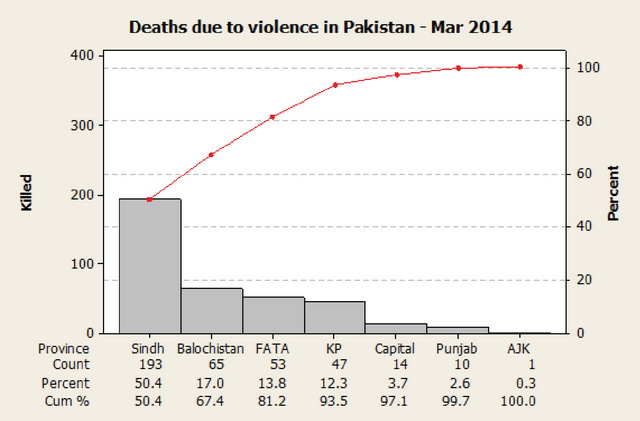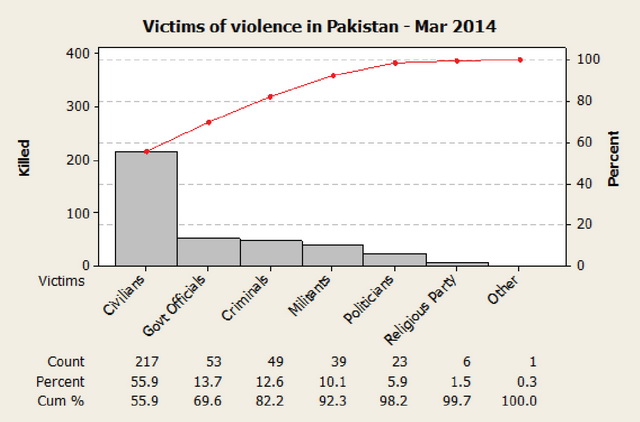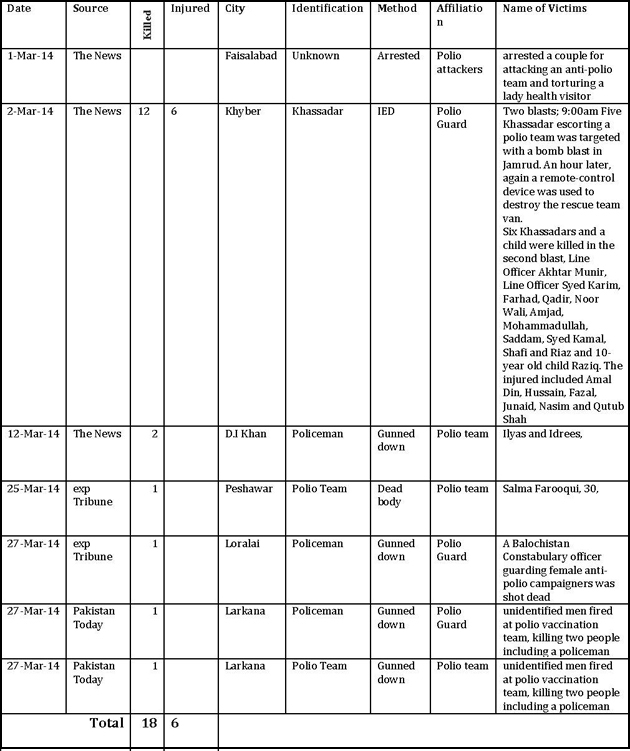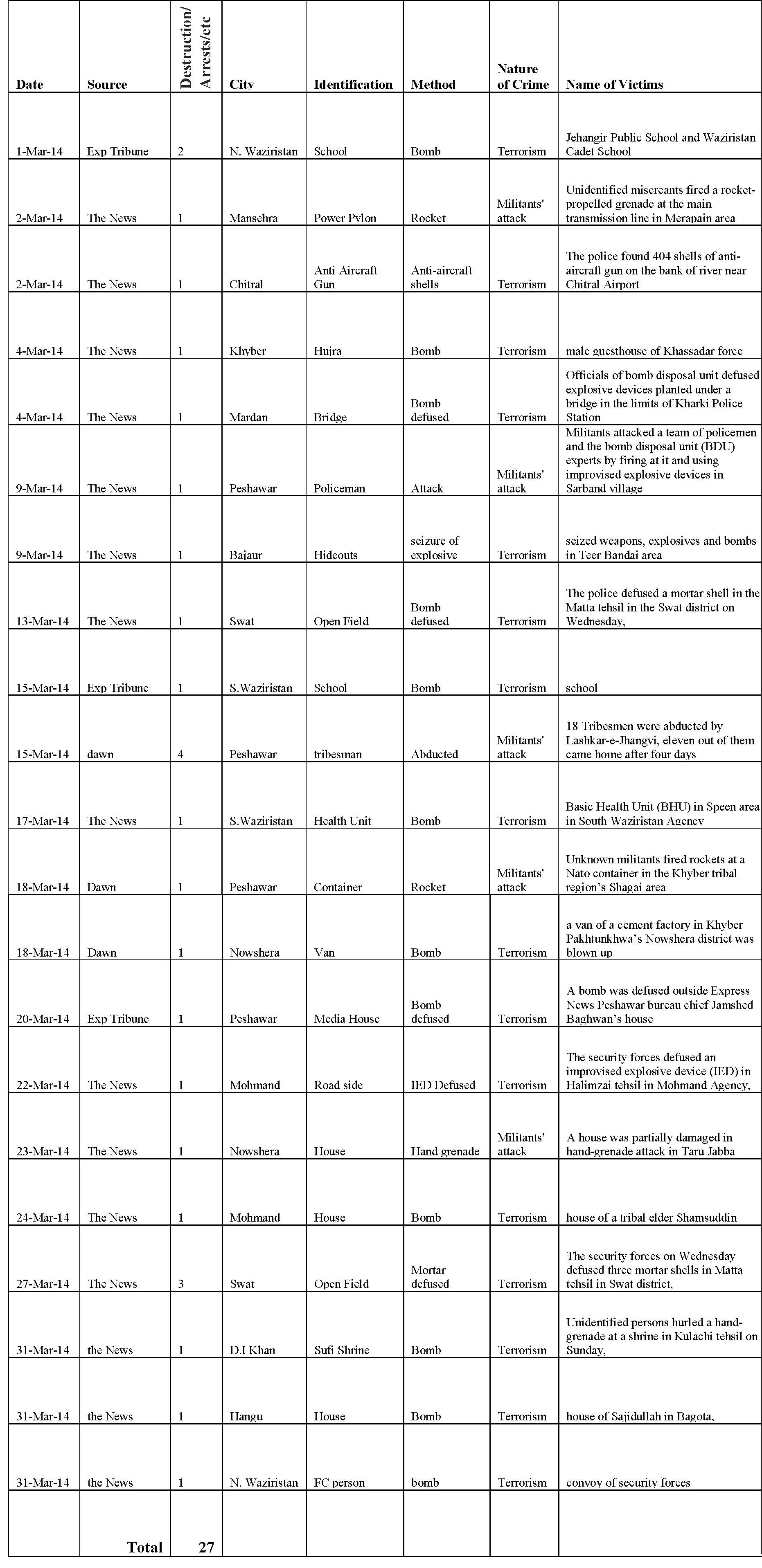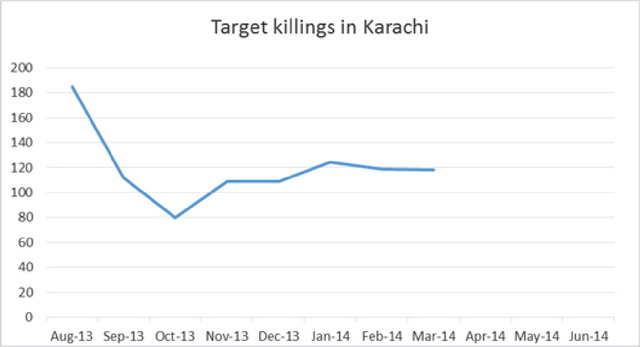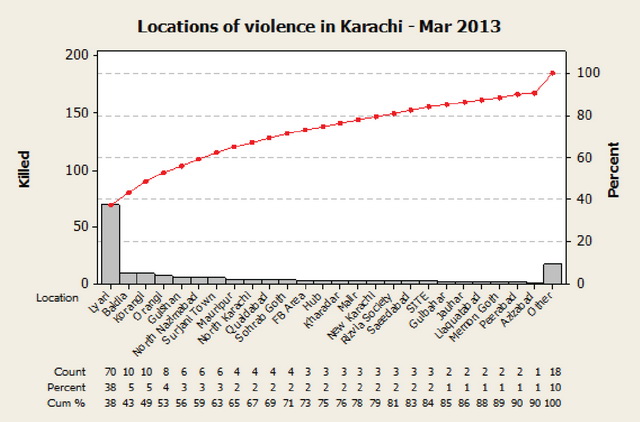A steep decline was observed in the loss of human lives in March 2014. This phenomenon could be attributed to the peace negotiations initiated by the government and the ceasefire observed by the Tehreek-i-Taliban and the government for the whole month. The number of deaths dropped from 571 in February to 385 in March, signifying a drop of 30%. Does this mean that acts of terrorism ceased or took on a new shape and form? The report will take a closer look at all the incidents of violence committed during March 2014 to answer the question above.
The targeted operation in Karachi came under criticism by some political and religious parties while the government showed no change in its policy regarding the operation. Targeted operation along with target killing, abduction, and dumping of dead bodies continued to plague the metropolis.
Sectarian violence also registered a downward trend during the month. However, an alleged act of blasphemy led to the desecration of Hindu worship places in Sindh by angry mobs creating fear among Hindus living in Sindh and Balochistan.
All these acts of violence and other facts reported in the national newspapers are collected to make this report as informative and factual as possible. Errors and omissions are always a possibility in statistical works including this one. However, such mistakes do not grossly affect the basic objective of this report. The report mainly covers the following topics:
Ceasefire and its observance
Casualties of militancy
Casualties of security operation
Attacks on Polio teams and their guards
Sabotage activities in FATA and KP
Sectarian violence
Target killings in Karachi
CRSS will appreciate receiving comments that the readers may have on this report.
Report prepared by:
Mohammad Nafees
Senior Research Fellow
Center for Research and Security Studies
NOTE: Readers can approach CRSS for source of any information included in the report. Please send your request to: [mail@crss.pk]
OVERVIEW
Deaths due to violence in the country during March 2014:
The casualties of violence in March 2014 were 736 (388 dead and 348 injured), nearly 30% lower than the last two month figures for fatalities (Refer graph 1 and table 1). The ceasefire announced by the Tehreek-e-Taliban Pakistan could be cited as a reason for this substantial reduction in death toll. There was a fall in all types of violence except target killings and mainly FATA and KP regions benefitted from this decline.
This decline in death toll also proved that the TTP is primarily responsible for the continued violence in Pakistan. The situation in Sindh and Balochistan remained unchanged because of the causes and the actors that trigger violence in these provinces (Refer to graph 2). Karachi, as usual, remained on top in loss of human lives. However, this month the capital Islamabad was also among the cities who suffered from violent acts (Refer to graph 3). Although, the TTP and the government agencies claimed to have been observing a ceasefire during March, yet 53government officials were killed during the month as opposed to 66 in February (Refer to graph 4). Last month, 166 militants were killed in different security operations while the figure reported for this month is only 39. It shows that the government was more observant of its commitment to ceasefire than the militants.
Graph 1: Deaths due to violence in Pakistan (Jan 2013 ´ Mar 2014):
Table 1: Casualties of violence in Pakistan (Jan 2013 ´ Mar 2014):
|
Violence Data – Jan 2013 – Mar 2014 |
|||
|
Month |
Killed |
Injured |
Total Casualties |
| Jan-13 |
641 |
388 |
1029 |
| Feb-13 |
461 |
330 |
791 |
| Mar-13 |
553 |
392 |
945 |
| Apr-13 |
432 |
544 |
976 |
| May-13 |
614 |
914 |
1528 |
| Jun-13 |
616 |
535 |
1151 |
| Jul-13 |
572 |
640 |
1212 |
| Aug-13 |
429 |
342 |
771 |
| Sep-13 |
492 |
547 |
1039 |
| Oct-13 |
287 |
275 |
562 |
| Nov-13 |
320 |
320 |
640 |
| Dec-13 |
280 |
325 |
605 |
| Jan-14 |
517 |
446 |
963 |
| Feb-14 |
570 |
361 |
861 |
| Mar-14 |
388 |
348 |
736 |
Graph 2: Number of people killed in provinces due to violence:
Graph 3: Number of persons killed in cities:
Graph 4: Victims of violence in June 2013:
Observing Ceasefire:
The ceasefire announced by the TTP and the government came under fire when several incidents of violence were claimed by the splinter groups of the Taliban. On 3rd March, two suicide attacks followed by indiscriminate firing at Islamabad district courts left 11 dead and 30 injured. Ahrar-ul-Hind, a splinter group of the Taliban whose name was never heard before, claimed responsibility. Among the 11 victims were a judge and a young female lawyer who had opted to come back to this country after completing her education in the USA. On the same day, there was a blast near a vehicle of Frontier Corps in Landikotal killing two FC personnel[1]. Nobody claimed responsibility for this attack while the Taliban condemned the incident.
Second incident took place in Kurram Agency on 6th March when a convoy of paramilitary soldiers became victims of a remote controlled bomb blast leaving six soldiers dead and 11 injured. A militant group Ansarul Mujahideen, which has been active in the tribal areas for the past three years, later claimed responsibility. ‘We have carried out this attack to avenge drone victims. We are not part of the Tehreek-e-Taliban Pakistan (TTP) so we are not bound by their ceasefire,’ the group spokesperson Abu Baseer told journalists by phone from an undisclosed location[2].
Two more violent incident occurred in Peshawar and Quetta on 15 March 2014 leaving 22 persons dead and nearly 90 injured [3] [4]. Ahrar-ul-Hind again took responsibility for the deadly attacks which killed innocent men, women and children.
These incidents of terrorism and militants– attacks left more than 40 persons dead and nearly 140 injured. The denials by the Taliban carried no weight for the families who had lost their loved ones or those left maimed and handicapped.
These incidents of militancy have raised a serious question about the commitment to the ceasefire agreed upon by the TTP and the government.
Casualties of militancy:
The casualties caused by militancy (militants– attacks[5] and terrorism[6]) were 310 (76 deaths and 234 injuries) during the month of March. The incidents took place in FATA, Balochistan, KP, and Islamabad (Refer Table 2).
Table 2: Casualties of militancy ´ March 2014
|
Casualties of militancy in Pakistan – March 2014 |
|||
| Province | Death | Injuries | Total |
| FATA |
29 |
32 |
61 |
| Balochistan |
22 |
93 |
115 |
| KP |
14 |
71 |
85 |
| Capital |
11 |
29 |
40 |
| Punjab |
0 |
9 |
9 |
|
Total |
76 |
234 |
310 |
The victims included civilians (47) and government officials (31). Among the government officials were Baloch Constabulary, Frontier Constabulary, Khassadar, and a Judge (Refer to table 3).
Table 3: Fatalities of government officials due to militancy ´ March 2014
| Victims of militancy ´ Mar 2014 |
Dead |
Injured |
| Baloch Constabulary |
1 |
|
| Frontier Constabulary |
17 |
39 |
| Judge |
1 |
|
| Khassadar |
12 |
6 |
| Political Agent |
0 |
3 |
| Total |
31 |
48 |
Casualties of security operation:
The security operations carried out by the different security agencies left 76 persons dead and 10 injured. Nearly 80% of the victims were from Sindh (39), Balochistan (29) and 10% from FATA (8). The casualties of security operation were 86 against 310 of militancy. The figure speak volumes about the seriousness and honesty of the militants in keeping their word and commitment in honoring ceasefire. Yet, a statement issued by the TTP spokesman, Shahidullah Shahid, blamed the government for increasing attacks on militant hideouts and raids on houses of its members in tribal areas[7]. According to the press reports, only two security operations were carried out in Khyber Agency in March and they were in retaliation to the militants– attacks. Following are the press reports:
Khyber firefight: Three militants killed in Bara clash [8]
Published: March 1, 2014
BARA: Three members of Lashkar-e-Islam (LI) militant group were killed in a clash with paramilitary troops in the Bara tehsil of Khyber Agency on Friday. Three others, including a commander and two Frontier Corps officials, were also wounded. An official said that fighters from Mangal Bagh Lashkar-e-Islam were passing through the mountainous area of Shalobar in Purdil Abad when they encountered paramilitary soldiers. The militants opened fire at the personnel, injuring two, while three LI members were killed in retaliatory fire, the official said. A commander, identified as Abdul Wali, was injured in the firefight.
Gunship helicopters kill five suspected militants in Khyber[9]
2014-03-02
KHYBER AGENCY: In response to the militant attack on a polio team in Jamrud which left at least 11 dead on Saturday, security forces– personnel launched a massive assault on Sunday morning on militant hideouts in parts of Bara and destroyed a number of them. Security sources confirmed that gunship helicopters struck the headquarters of Mullah Tamanche involved in the attack on polio workers. The Ayubi Markaz of Mullah Tamanche in Bara was destroyed in the airstrikes whereas five suspected militants were killed, the sources said. Gunship helicopters also targeted militant hideouts in Kalanga and surrounding areas and a number of them were destroyed.
Attacks on Polio team and their guards:
Taliban were very prompt in denouncing acts of violence carried out by their splinter groups in Kurrum Agency, Islamabad, Peshawar, and Quetta, but they conspicuously failed to show a similar reaction to the killings of twelve (12) Frontier Constabulary personnel in Jamrud who were escorting a Polio team. When the security forces retaliated to this breach of ceasefire by one of the Taliban commanders, Mullah Tamanchi, the Taliban came out with their condemnation and a threat to resume attacks across the country. During March, 18 persons lost their lives while providing a service that helps save children from being crippled (Refer to the Table 4). The lack of concern and sympathy for the victims gives an insight about the motives and mindset of the Taliban. Taliban are against polio vaccination and has killed numerous people including women. All those who died in March either working as Polio team members or providing security to Polio teams were suspected to be part of the Taliban campaign against Polio vaccination in the country.
Table 4: Polio team and their security cover under attack
Sabotage activities in FATA and KP:
Taliban are also suspected of being involved in sabotage activities resulting in damage to government and public properties. Following the announcement of ceasefire, it was expected, that there will be an end or considerable reduction in their sabotage activities. The data collected disproves such expectations. During March, a number of government and public properties were fully or partially damaged due to bomb and rocket attacks in FATA and KP. Public schools, health units, bridge, houses, and hujras were targeted in these attacks (Refer to Table 5). The sabotage activities carried out in Balochistan and Sindh are not included in the following table because the actors and factors involved in those regions are different from KP and FATA though the Taliban have penetrated in these regions as well.
Table 5: Sabotage activities in FATA and KP ´ March 2014
Instead of blaming the government, the Taliban must give substantial proof to support their claim against government insincerity in their commitment to honor ceasefire. The available data does not support their claim.
Sectarian violence:
Sectarian violence showed a drop of 50% in March. Karachi topped the list in this regard and lost about 14 persons from out of 15 causalities with 11 being from the Shia community. Shia community has been one of the most targeted minority groups in case of sectarian violence. Another minority that suffered violence and desecration of its places of worship in March were Hindus living in Sindh. On 15 March 2014, a frenzied mob in Larkana set a Hindu Dharamshala on fire over alleged desecration of holy pages by a Hindu boy.
Next day, angry residents of other cities and towns of upper Sindh as well as in Suhbatpur, Dera Murad Jamali, Dera Allayar, Gandakha and Usta Mohammad in Balochistan held protest rallies and caused disturbance and destruction in the area. Three protesters and one policeman were injured during clashes in Usta Muhammad, while 10 shops owned by Hindus were set ablaze, according to senior police official Syed Ashfaq Shah. There was no violent reaction from Hindu community against the destruction of their properties and desecration of their holy place. Meanwhile, Larkana Hindu Panchyat President Kalapna Devi expressed her shock and sorrow over the incident. ‘I strongly condemn the desecration of the Holy Quran and demand the accused be punished if he really has committed [blasphemy]’, she told The Express Tribune[10]. Despite the calmness on the part of the Hindu community, incidents of desecration of their holy places continued in different parts of Sindh. One Mandir was desecrated in Hyderabad and another one in Tharparkar.
Desecration of holy places has become common in Pakistan whether Muslim or No- Muslim. In March a shrine of a Muslim Sufi in D.I. Khan came under hand grenade attack by some unidentified persons in Kulachi tehsil (Refer Table 6).
Table 6: Desecration of holy places in the country ´ March 2014
Target killings in Karachi:
There was no respite in the number of victims falling prey to the ongoing target killings in Karachi during March (Refer graph 4). Despite a peace agreement between the two main rivals of Lyari gang war ´ Uzair Baloch group and Baba Ladla group, loss of human lives in Lyari remained the highest (Refer graph 5). The victims belonged to one or the other group while some were innocent people caught in the cross fire. Would the peace between the two main rivals bring a permanent peace to the affected area is a question that remains to be answered in the coming months. Like the militancy ridden FATA and KP regions, Karachi also has a variety of militant groups engaged in different unlawful activities. In Lyari alone, the victims of violence during this month were found affiliated to nine different following groups:
- Uzair Baloch group
- Baba Ladla group
- Lala Orangi Wala
- Faisal Pathan group
- Shakeel Badshah group
- Ghafoor Bugti gang
- Shakeel Commando
- Sheraz Comrade Group
- Ghaffar Zikri group
With so many groups operating in Lyari it is difficult to find ways and means to bring peace in the area.
Graph 5: Deaths due to target killings in Karachi ´ Mar 2014
Graph 6: Locations of violence in Karachi ´ Mar 2014
Among the 40 dead bodies found throughout the country in March, 20 were from Karachi alone. A young man in his mid-20s was found slaughtered in North Karachi. Security operations carried out by the police and rangers left 39 suspects dead and several hundred criminals arrested in the city. The target killings on sectarian grounds resulted in the deaths of 11 persons belonging to Shia community, 2 from Sunni community, and one from Christian community.
The victims of violence in Karachi belonged to different groups of Lyari gangs followed by the activists and supporters of political and religious parties like MQM, ASWJ, PPP, ISO, PMLF, Shabab-e-Milli. Robbers, land grabbers, and other criminals are also active in Karachi posing multiple challenges for the law enforcement agencies. According to the press report, Rangers claimed that during the targeted operations in last six months they have recovered bulletproof jackets, mixed ammo and over 3,236 weapons ´ including RPG-7, uni-barrel rocket launchers, hand grenades, light machine guns, SMGs, rifles, shotguns, pashpasha rifles, sniper rifles, pistols, explosives, improvised explosive devices and detonators[11].
Like FATA, KP, and Balochistan, the Police and Rangers in Karachi are faced with criminals who have weapons such as rocket launchers, light machine guns, IEDs, and SMGs. The law enforcement agencies are significantly poorly equipped and untrained to counter such well-armed and well trained criminals. This may be one of the reasons why police department is losing personnel to target killings and other forms of attacks and why crime rate is not declining in Karachi.
Conclusion:
All indicators of violence, with the exception of target killing, showed a sharp decline during the month of March (Refer to table 7) and it is a good sign for restoring peace in violence ridden country of Pakistan. The incidents of violation of ceasefire commitment are serious issues that need to be paid attention by the parties, the Taliban and the government. The whole intent and purpose of the peace talks will be jeopardized if sincerity and honesty are not maintained by the two groups.
Table 7: Deaths due to violence in Pakistan ´ Jan ´ Mar 2014
The continued target killings in Karachi and raises serious questions about the effectiveness of the operation and the authorities need to revisit their policy and find solutions that can really bring tangible results.
[2] http://tribune.com.pk/story/679540/restive-frontiers-kurram-convoy-attack-leaves-six-soldiers-dead/
[3] http://tribune.com.pk/story/683145/ahrarul-hind-claims-responsibility-for-peshawar-quetta-blasts/
[5] suicide attack, hurling of hand grenades, indiscriminate firings by the groups of militants, etc.,
[6] installation of bomb, IED, landmine, etc.,
[9] http://www.dawn.com/news/1090532/gunship-helicopters-kill-five-suspected-militants-in-khyber
[10] http://tribune.com.pk/story/683725/communal-riots-hit-sindh-balochistan-cities/


